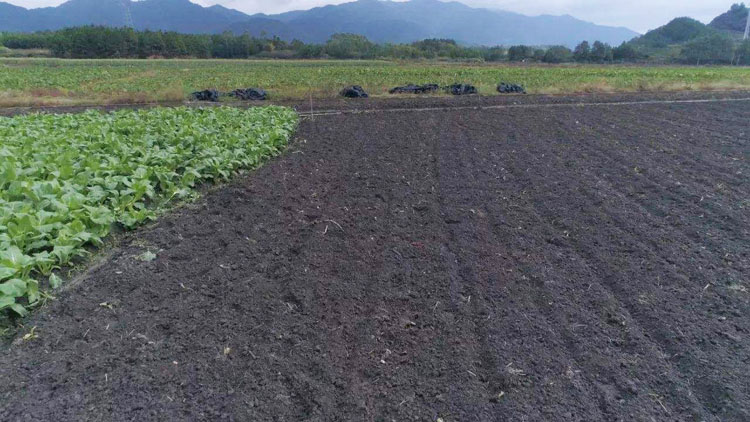How to judge soil fertility and acidity?
VIEWS: times Release Date:2020-08-17
How to distinguish the level of soil fertility? How to distinguish whether the soil is acidic or alkaline? And the improvement methods of acid soil and alkaline soil. Let's introduce it in detail next, let's take a look!

1. How to distinguish the level of soil fertility
Fertile and high soils are generally rich in humus and organic matter. The color is mostly dark soil (such as black, brown, brown), deep soil layer (30-60 cm and above), loose soil, non-sticky, non-condensed It is not dry and hard, and has good water permeability. There are also more microorganisms and earthworms underground, and there are often night tides. When the weather is dry, there are many small cracks on the soil surface. When watering, water will quickly penetrate the ground, and the water surface will easily become muddy. The soil in the Northeast is generally more fertile. In addition, in fertile soil, weeds generally grow early, much longer, and grow faster, and the yellowing time is relatively late.
Low fertility soil generally contains less humus and organic matter, and the color is mostly light-colored soil (such as light yellow, yellow-white, and light white). The top soil is shallow (below 30 cm), and the soil is relatively dry and hard, with permeability and permeability. Water retention and fertilizer retention are poor, easy to harden and crack after rain or watering, with few, large and deep cracks, slow water penetration and clear water quality during watering, and no night tide in the soil. The plots with less underground microorganisms and more ants in the fields are mostly soils with lower fertility.
Generally speaking, plots with rich soil have good water retention, fertilizer and heat preservation capabilities, and sufficient nutrients, which are more conducive to crop root development and nutrient transformation, and grow crops of better quality and higher yield. The opposite is true for plots with low soil fertility.
In addition, in addition to the factors of soil fertility, the growth of most crops is most suitable for acid-base balance or slightly acidic or slightly alkaline or slightly acidic and slightly alkaline soil environment, which is also conducive to the growth and activities of microorganisms. Therefore, after understanding the fatness and leanness of the soil, it is best to know whether your soil is acidic or alkaline.
2. How to distinguish acid soil from alkaline soil
Acidic soil, the humus content is mostly dark brown, thick soil, loose soil, strong water permeability, relatively soft in the hand, moist soil is not easy to hold into blocks, watering on the surface does not bubbling, the water surface is muddy, it can be very It penetrates into the underground soil quickly, and it is easier to dig the soil.
Alkaline soil, mostly light yellowish white in color, thin soil layer, hard soil, poor water permeability, relatively hard to grasp in the hand, and moist soil is easy to hold into a clump and hard to disperse after letting go , Watering on the surface often produces white foam, the water surface is not muddy and the penetration into the underground soil is slow, and the digging of the soil is very digging or very difficult.
3. Acidic or alkaline adjustment
For acid soil improvement, the acidity can be adjusted by increasing the amount of decomposed farm manure or organic fertilizer, spreading quicklime, and irrigating acid.
Alkaline soil improvement can be adjusted by increasing the amount of decomposed farm manure or organic fertilizer, mixing green manure/pine needle soil, combined with superphosphate/diammonium phosphate, and spreading gypsum.
Previous : Best NPK fertilizer for lotus
Next : NPK 14-14-14 compound fertilizer
Latest News
- The company overcame difficulties and won a "good start" in the first quarter ...2022-03-28
- Safe Production ...2022-03-28
- first-line collection ...2022-03-26
- Huaqiang News ...2022-03-26
- Huaqiang Chemical Strong Agriculture Project ...2022-03-25
- huaqiang news ...2022-03-24
- winning unit ...2022-03-22
- Huaqiang News ...2022-03-21
Related Information
- The best fertilizers for fruits and crops ...2020-05-26
- Huaqiang Chemical Group NPK fertilizer pdf ...2020-04-01
- Humic Acid Fertilizer ...2019-12-31
- Bulk Blending Fertilizer ...2019-12-27
- Water Soluble Fertilizer ...2019-12-08
- NPK Fertilizer ...2019-12-02
- Potassium Sulfate Fertilizer ...2019-11-30
- Urea Fertilizer ...2019-11-21
MESSAGE
Our sales staff will be the first time to get in touch with you,to provide you with the latest price.
-
Chemical Products
-
Compound fertilizer
-
Contact Us
Huaqiang Chemical Group Stock Co.,Ltd.
No.1 Jinping Avenue, Dangyang , Hubei , China
Http://www.hq-chemical.com
info@hq-chemical.com
Tel:+86 717 3431866
Mobile: +86 18627120543
© Copyright 2021 Huaqiang Chemical Group Stock Co.,Ltd. All Rights Reserved



